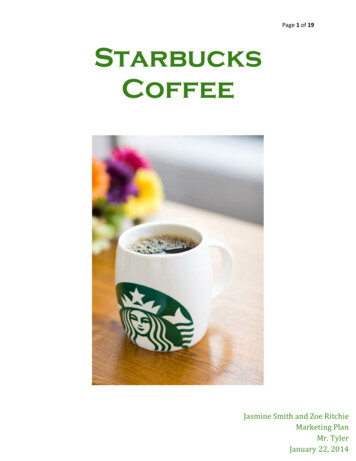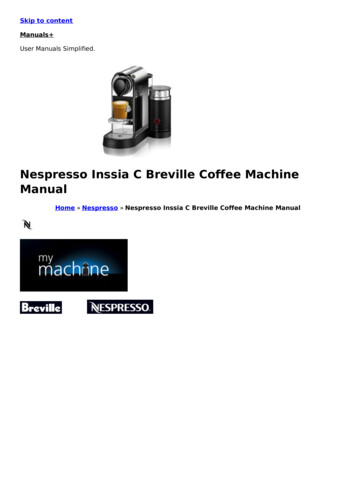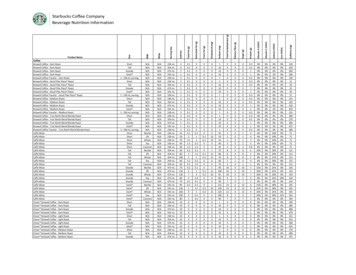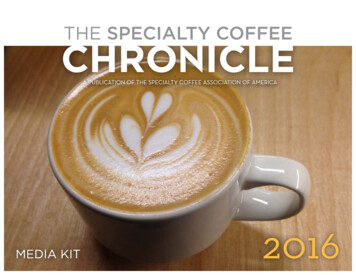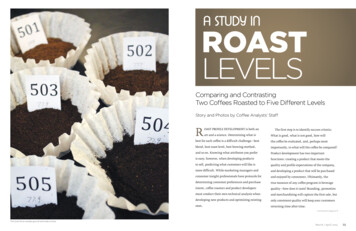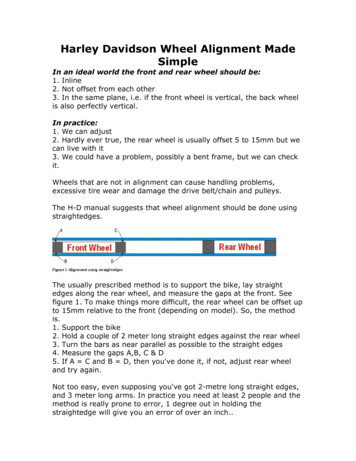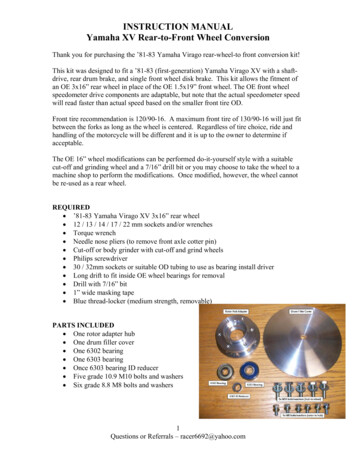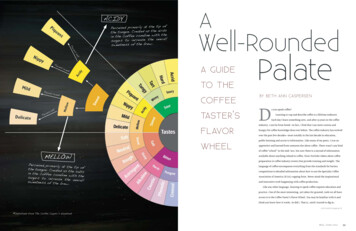
Transcription
ACIDYPiquofPerceived primarily at the tipdsacithe tongue. Created as thein the coffee combine with thelsugars to increase the overalsweetness of the teTotsalMellrdwaMELLOWPerceived primarily atthe tip ofthe tongue. Createdas the saltsin the coffee combine with thesugars to increasethe overallsweetness of the brew.Sweetrd sweeowMildAWell-Roundeda guideto thecoffeetaster’sflavorwheelPalateby beth ann caspersenDo you speak coffee?Learning to cup and describe coffee is a lifetime endeavor.Each day I learn something new, and after 15 years in the coffeeindustry, I am far from bored—in fact, I find that I am more curious andhungry for coffee knowledge than ever before. The coffee industry has evolvedover the past few decades—most notably in the last decade in education,public learning and access to information. Like many of my peers, I was anapprentice and learned from someone else about coffee. There wasn’t any kindof coffee “school” in the mid-’90s, but now there is a myriad of informationavailable about anything related to coffee, from YouTube videos about coffeepreparation to coffee industry events that provide training and insight. Thelanguage of coffee encompasses everything from the standards for baristacompetitions to detailed information about how to use the Specialty CoffeeAssociation of America (SCAA) cupping form. Never mind the inspirationaland innovative work happening with coffee production.Like any other language, learning to speak coffee requires education andpractice. One of the most interesting, yet taken-for-granted, tools we all haveaccess to is the Coffee Taster’s Flavor Wheel. You may be familiar with it andthink you know how it works. So did I. That is, until I started to dig in.continued on page 40*Definitions from The Coffee Cupper’s Handbook38roastMay J u n e 2 0 1239
A Well-Rounded Palate A Guide to the Coffee Taster’s Flavor WheelI started researching the origin of this tool over the past yearbecause I will be creating a cross-product sensory training for coffeeand chocolate liquor, one that will use the lessons learned in our worldof specialty coffee and provide more structure than is currently beingused in specialty cocoa. So rather than create a new set of terms, whynot borrow from other food products? As I started to take the time tothink, read and reflect on the Coffee Taster’s Flavor Wheel, I realizedI had opened up a can of worms that merited a discussion with thewider specialty coffee community.(continued)The Flavor Wheel:A Historical PerspectiveThe flavor wheel has enjoyed 15 years in existence. It is used by themost seasoned coffee cuppers and newbies to boot, it employs familiarand professional vocabulary that is technical but approachable, and itadorns the walls of coffee professionals around the world. There havebeen thousands of copies sold since the first printing, and the wheel isavailable in both English and Spanish. The Coffee Taster’s Flavor Wheelwas created in the late 1990s for the SCAA by Ted Lingle, the formerexecutive director of SCAA and current executive director of the CoffeeQuality Institute.There are two coffee tasting wheels on the poster; the left siderefers to taints and faults, and the right side contains distinct aromaand flavor tasting attributes found in coffee. Time and again, theflavor wheel has been an invaluable resource for coffee professionals;it’s an easy way to provide terms for flavor, create confidence for thetaster and help cuppers jog their memory when a tasting term is quiteCoffee taster’s flavor wheelliterally on the tip of the tongue.I have spent the last 10 years training cuppers and working tocreate a common vocabulary with our producer partners. Whenexplaining the flavor wheel, I spend the majority of my time lookingat the wheel on the right side of the poster and focusing on the morepositive attributes of coffee. This right hand wheel is divided into twosections: tastes and aromas. The graphics and terms are easy to referto in a silent room full of cuppers, no matter what level of experience. Istill refer to it to see if the power of suggestion may provide me with anadvanced term not found on the colorful poster.Though the flavor wheel is a great tool, I have always had afew questions about the way it was created, such as why specificdescriptors like “tea rose” are used, while taste terms like “umami”are absent. I knew I had to start with Lingle to gain some historicalperspective.Lingle worked with a group of people to refine his thinking andphoto courtesy of Equal Exchangeideas around creating a common vocabulary. This was based on hisown work and his creation of multiple glossaries of words that thecoffee industry was in need of; thus, The Coffee Cupper’s Handbook wasborn in 1985. “We needed a more expansive language [for coffee],”Through my own work and years of training with producers, cuppershe told me, and The Coffee Cupper’s Handbook worked to address thisand clients, I had developed what I thought to be a logical way toneed. The first version was introduced to the small group of coffeeroastexplain the flavor wheel. But when I went back and re-read The Coffeeprofessionals that had organized the SCAA. As the years passed, theCupper’s Handbook I was struck by the complexity of it. The flavor wheelSCAA progressed in its thinking and attracted new members and ais an important resource that needs acknowledgement as a profounddeeper understanding of coffee flavor. It was only after a conversationpiece of work in specialty coffee. Although the scientific appeal foundwith a colleague, Jeff Babcock of Seattle’s Zoka Coffee Roaster & Tea,in The Coffee Cupper’s Handbook may not be the easiest to understand or thethat Lingle decided to transform The Coffee Cupper’s Handbook into themost approachable for many people (regarding the aroma and flavorCoffee Taster’s Flavor Wheel poster.40What coffee professionals may not know is that the flavor wheelwas created as a visual tool to accompany The Coffee Cupper’s Handbook.continued on page 42May J u n e 2 0 1241
A Well-Rounded Palate(continued)terms), nonetheless the foundation is solid. It may require morefuture work to make it more accessible to everyone.After learning that the two tools were meant to work together,I was surprised to see that there wasn’t any indication on the CoffeeTaster’s Flavor Wheel that one needed the handbook to interpretthe imagery. It seems like the relationship between these twopieces is recommended as opposed to vitally dependent on oneanother.The Value of Production CuppingThe Coffee Taster’s Flavor Wheeland The Coffee Cupper’s Handbook canprovide insight into the way youproduce coffee for your customers.One of the most effective tools is avery basic and old-school methodFaults and Taints WheelThe left side of the poster refers to the negative effects on coffeethrough five groups—harvesting/drying, storage/aging, roasting/caramelization, post-roasting/staling and post-brewing/holding.of analyzing coffee roasts througha process known as productioncupping. At Equal Exchange, each daysamples from each batch of roastedcoffee are brought to the lab andcupped the following morning. EachBasically anything that has gone wrong with a coffee would likelysample lists the name of the coffee,end up on the faults and taints wheel. As you may have guessed,degree of roast, colorette numbercoffee cannot remain in a constant state of equilibrium through(color spectrometer) and the numbereach of these stages, and when things go awry, the characteristicsof the roast for that day. Coffees areare best described through the faults and taints wheel. Essentially,organized by origin and in order of roast degree. Companies do this tothis is the problem side of the Coffee Taster’s Flavor Wheel.According to the Coffee Cupper’s Handbook, “If the change results ina minor flavor defect, usually limited to the aromatic properties ofthe flavor, it is referred to as a flavor taint. Whether a flavor taintis pleasing or displeasing depends on its type and degree, as well asthe cupper’s personal preference. If the chemical change results ina major failing, usually transmitted to the taste properties of theflavor, it is referred to as a flavor fault. Flavor faults are almost always displeasing, regardless of the cupper’s personal preference.”AromasAroma (otherwise known as fragrance, nose, aftertaste) is thegeneral term used to encompass all stages of smelling coffee on theBeth Ann Caspersen at aproduction cupping.photo courtesy of Equal Exchangeanalyze the consistency from roast to roast of the same origin coffee (orblend) and to verify/confirm the characteristics they want to see come outof a particular coffee. Investing in this system requires time, energy andfollow-through, but the results can be tremendous.After each cupping is finished, the cuppers (both roasters and qualitycontrol folks) evaluate each of the coffees, talk about what they liked,what needs to change and how to make informed changes. Feedbackand production cupping notes may then be sent to the purchasing,quality-control and roasting teams each day with flavor descriptions andrecommendations.Production cupping every roast creates a solid feedback loop thatincludes everyone in the process and builds excitement and sharedresponsibility. It’s also a great way to encourage various levels ofexperimentation. If you are not production cupping in your roastery,consider it. It’s a solid investment in the quality of your coffee.—Beth Ann Caspersenflavor wheel. The aromas found in coffee are experienced throughthe nasal passage, sending a message to the olfactory bulb in thebrain. The cupper then translates this message into a word like“fruity.” When you look at the aromas on the flavor wheel, youwill find a general category called “enzymatic,” which is linkedto the “fruity” term. From this point, you have the option of twodifferent fruit categories (“citrus” or “berry-like”) and more termsto describe different fruit options. You look at the wheel, dig deepinto your memory for the aroma you are experiencing, and thenwork through the possible term to match your beliefs. This is howthe vast majority of cuppers likely use the flavor wheel.However, the aroma side of the wheel lists three primaryterms: “enzymatic,” “sugar browning” and “dry distillation.” Thisis where I started to create a few conflicting arguments. I wonderedif the flavor wheel was created as a way to evaluate coffee in asample cupping or roasted coffee in a production cupping. Whencupping samples from our producer partners, we use a light roastand evaluate the cup characteristics with the SCAA cupping form.All of the roast colors are the same, however we sometimes finddistinctive aromas like maple syrup or cloves.42roastThe ColorsI always thought that the colors of the wheel were attractive andseemed to express the terms they surrounded—light yellow forlemon, dark brown for chocolate—but what I learned from Linglewas that the amount of time and energy put into the color schemewas not a whimsical arrangement related to terms, but that eachterm was very purposefully put in place to represent the weight ofthe molecules that they were meant to represent. For example, theenzymatic category and the terms associated with it actually containa lighter molecular weight than those found in the dark purplecolors seen in the dry distillation category.In addition to the significant importance of molecular weight,the aroma categories also have specific definitions that refer tothe way the coffee was grown, the development of sugars in theroasting process, and bean fiber. Terms like “coffee blossom” in theenzymatic category refer to the development, maturity and terroircontinued on page 44May J u n e 2 0 1243
A Well-Rounded Palate A Guide to the Coffee Taster’s Flavor Wheel(continued)found in the coffee, while a term like “maple syrup” in the sugar“dearth” of words available in the English language to describe flavor.open passage between the palate and the nasal passage that allows usbrowning category indicates the development of sugars. And, finally,In the taste category, you don’t find the wide-reaching descriptionsto experience these characteristics retro-nasally; thus, they becometerms like “clove” from the dry distillation directly reflect bean fiber.that one associates with actual flavors. What was interesting to mepart of our flavor description.Another tool that coffee professionals have is the set of aromawas the idea that aroma captures many of the sentiments we have asvials that were developed by Jean Lenoir, the famous creator of wine,cuppers, but the actual flavor terms of sweet, sour, salt and bitter seemchampagne and cigar aroma kits. For coffee, Lenoir had specific ideasto be a limiting group.about the aromatics found in coffee, as did Lingle. Upon meeting inImagine a scenario where you identify a coffee as being sweet; theParis to begin working on the aroma vial kit, they found that theirflavor wheel provides you with more taste options within the sweetideas were in alignment. Amazingly enough, with all of the possiblecategory, and you decide the coffee flavor “mellow” does the best job ofaromas you could find in coffee, these two professionals were ablecapturing your sentiments (see page 38 for a cross-section of this part ofto settle on a list of 36 terms. Through their process of exchangingthe wheel). You now have the option to take “mellow” a step further;information, they had to change only four terms to come to anyou are left with two more options: “mild” and “delicate.” Both tastingagreement. Considering the wide variety of terms that many cuppersterms are familiar; they seem similar in concept and are widely used.find outside of the aroma section of the flavor wheel, this is veryHow are they different? It seems like tasters could proceed at this pointinteresting.with a judgment call and interpret the words in whatever way theyThe TastesYou may have learned about four basic tastes through an SCAA class,the Q-grader course or your own background and curiosity aboutfundamental flavor.At the center-left side of the right flavor wheel you will see theterm “tastes.” Skirting this word are the four basic tastes believed tobe in coffee: sour, sweet, salt and bitter. Lingle pointed out that notonly are there fewer terms on this side of the wheel, but that there is a44roastwant to. But that is not the intended use for the taste side of the flavorwheel. The vocabulary used refers to specific measurements withadjacent flavors on the wheel contributing to the intensity of a specificflavor. Use the flow chart breakdown for descriptions, which will helpcuppers justify why one term is better than another.The flavors you experience on the cupping table or enjoy in yourbrew encompass the basic four flavors of sweet, sour, salt and bitter.Though the basic four don’t sound like the sexy terms we like to useto describe the fine attributes in coffee, terms like “apricot” or “maplesyrup” are actually aromatics that are described as flavors due to theWhat About Umami?After attending the Applied Sensory and Consumer Science Certificatephoto courtesy of Equal ExchangeProgram at the University of California, Davis, I was certain that theplums are not on it.) The flavor wheel has always provided my mindbasics of flavors were not fairly represented on the flavor wheel. Forwith freedom and creative license, but upon reading The Coffee Cupper’sone, an important discovery made about the way food products canHandbook, I began to look at the wheel through a more restrictive andtaste, dubbed “umami,” was not being represented. I wondered ifless creative lens.there were plans to include this fifth taste in a future version of theI had never thought of the flavor wheel as a limiting tool, butflavor wheel. However, Lingle has an opposing opinion about umami.rather a way to encourage tasters to dig into their aroma and flavorHe asserts that the flavor of umami is a modulated version of saltmemories and pull out a term that would be interpreted through theintroducing fat—basically a merger of salt with water-soluble oil,coffee they are tasting. What I learned is that the right-hand wheel,much like the flavor of seaweed and widely known as monosodiumthe one containing tastes and aromas, is believed to represent theglutamate (MSG). Therefore, he says, it is a subset of salt on the Coffeelimits in coffee. Knowing that green coffee contains more than 200Taster’s Flavor Wheel.chemical compounds before it is roasted and hundreds more afterThe LimitsLet’s assume that the flavor wheel is open to interpretation and thatit can be used in many different ways. What happens when there is adescriptor that is not listed on the flavor wheel? (I am certain that umeroasting, shouldn’t there be more than 36 aromas and four basic tastes?It makes sense that cuppers would venture outside the lines of theflavor wheel when encountering a particular aroma memory, which isbased on experience and access to the vocabulary presented. However,the flavor wheel is meant to create a common vocabulary. I believe itcontinued on page 46May J u n e 2 0 1245
A Well-Rounded Palate A Guide to the Coffee Taster’s Flavor Wheel(continued)does that, plus it encourages cupper calibration. But does it stopthere?At this point, there are no plans to change or update TheCoffee Cupper’s Handbook or the Coffee Taster’s Flavor Wheel. I canappreciate the wheel as it has been described and the value I findin using it for my own business and training. However, thereare many interesting discoveries in the food industry, and I don’tthink it could hurt to review the contents, descriptions and workto get more out of it. If at the end of the investigation we find thatthe wheel will remain the same, so be it. But it doesn’t hurt toreview and make changes as they come about (the third edition ofThe Coffee Cupper’s Handbook dates back to 2001).Other Flavor WheelsThere are many different kinds of flavor and aroma wheels in themarketplace, including wheels for perfume, beer, cheese andwine. I had always used the Coffee Taster’s Flavor Wheel for pureBeerWheel American Societyof Brewing Chemistsvocabulary and relied on the rating system of the cupping formatsand standards created by the SCAA by which to grade coffee. Butnow I am re-learning this vocabulary to further identify precisemeasurements. In doing so and in exploring the wide world offlavor, I ventured into some other delicious food categories toexplore ways that their educational and training in sensory wouldbring clarity or more experience into the coffee industry. I alsowanted to see what terms may be universal. The coffee industryborrows so much from other specialty foods. Though we havecarved out our own thinking and stand tall with our creativedescriptions, it never hurts to learn more.Some say it’s cliché to compare specialty coffee to the wineindustry, but I have found that this is a simple way to engagethe consumer. We should be looking to other specialty foods andlearning about ways to further our own thinking and sharinginformation for other foods industries. In talking about the CoffeeTaster’s Flavor Wheel with Lingle, I referenced the beer industryand the wide vocabulary around basic mouthfeel terms (whichby the way, is not represented through the Coffee Taster’s FlavorWheel, but is available through The Coffee Cupper’s Handbook) and theWineWheel Ann C. Noble,winearomawheel.comimportance of keeping an open mind. We may have three decadesunder our belt as a specialty coffee industry, but people have beenmaking cheese, beer and wine way longer than that. In the coffeeindustry, we may have created some formal structures to talkabout what we taste, but, in my mind, we are nowhere close tofinished, so let’s keep on talking and learning.Beth Ann Caspersen is quality control manager for EqualExchange, an importing and coffee-roasting
sample cupping or roasted coffee in a production cupping. When cupping samples from our producer partners, we use a light roast and evaluate the cup characteristics with the SCAA cupping form. All of the roast colors are the same, however w


